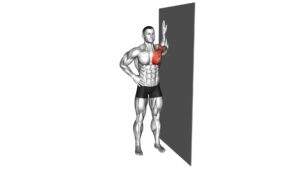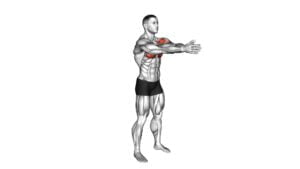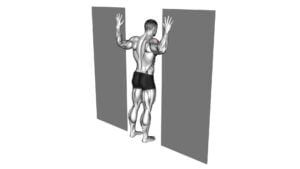Standing One Arm Chest Stretch – Video Exercise Guide & Tips

Get ready to improve your chest flexibility with the Standing One Arm Chest Stretch! In this video exercise guide, we'll show you the proper form and technique to stretch your chest muscles effectively.
Watch This Exercise Video
Whether you're a beginner or an advanced fitness enthusiast, we've got modifications and variations to suit your needs. Follow our tips to maximize the effectiveness of this stretch and unlock the benefits for your upper body.
Let's get started!
Key Takeaways
- The Standing One Arm Chest Stretch improves flexibility, posture, and shoulder mobility while reducing the risk of injury.
- Resistance bands or towels can be used to provide resistance and deepen the stretch, but alternatives like belts or long scarves can also be used.
- Proper form includes maintaining a straight posture, standing tall with feet hip-width apart, and slowly rotating the torso away from the extended arm.
- Variations of the stretch include seated or partner-assisted variations, standing on a stability ball, and modified positions for those with difficulty standing. It is important to maintain proper form and incorporate the stretch into a regular exercise routine for maximum flexibility.
Benefits of the Standing One Arm Chest Stretch
To maximize your flexibility and improve your posture, you should incorporate the standing one arm chest stretch into your exercise routine. This stretch is beneficial for both chest flexibility and shoulder mobility.
By stretching your chest muscles, you can improve the range of motion in your shoulders and upper back, allowing for better posture and reduced risk of injury. The standing one arm chest stretch targets the pectoralis major and minor muscles, which are located in the front of your chest.
These muscles can become tight and shortened due to activities like sitting for long periods or performing repetitive movements. By regularly stretching them, you can lengthen and release tension in these muscles, improving flexibility and reducing stiffness.
Additionally, this stretch helps to open up the chest, which can counteract the effects of slouching and rounded shoulders. By incorporating the standing one arm chest stretch into your exercise routine, you can improve your chest flexibility and shoulder mobility, leading to better posture and overall physical well-being.
Equipment Needed for the Exercise
To perform the Standing One Arm Chest Stretch, you'll need some equipment. The required equipment for this exercise is minimal, making it accessible for most individuals.
However, there are also alternatives available if you don't have the specific equipment on hand.
Required Equipment for Exercise
You will need equipment for this exercise.
To perform the Standing One Arm Chest Stretch, you'll require some exercise equipment and stretching tools. The main equipment you'll need is a resistance band or a towel. A resistance band is a versatile piece of equipment that can help increase the effectiveness of your stretches. It provides resistance and allows you to deepen your stretch gradually.
If you don't have a resistance band, a towel can be used as an alternative. Simply fold the towel lengthwise and hold onto both ends for a similar stretching effect. These simple tools will aid in targeting your chest muscles and improving flexibility.
Now, let's move on to the next section about the minimal equipment needed for this stretch.
Minimal Equipment for Stretch
You'll need some minimal equipment for this stretch. Here are five options for equipment that can enhance your stretching routine:
- Resistance band: Using a resistance band can provide a deeper stretch and help improve flexibility.
- Yoga strap: A yoga strap can assist in achieving a deeper stretch by extending your reach.
- Foam roller: Incorporating a foam roller into your stretching routine can help release tension in your chest muscles.
- Wall or doorframe: Utilizing a wall or doorframe can provide support and stability during the stretch.
- Yoga block: A yoga block can be used to modify the stretch and make it more accessible for beginners.
These equipment options can enhance your stretching experience and help you achieve the best stretches for your chest muscles.
Experiment with different options to find what works best for you and always prioritize safety and proper form.
Equipment Alternatives for Stretch
Consider using these equipment alternatives to enhance your stretching routine for the standing one arm chest stretch.
If you don't have access to a resistance band or a towel, you can still achieve an effective stretch by using alternative options. One at-home modification is to use a belt or a long scarf instead of a resistance band. Simply hold one end of the belt or scarf in your hand, and extend your arm out to the side, pulling gently to create tension.
Another option is to perform the stretch against a wall or a sturdy piece of furniture. Place your hand on the wall or furniture and lean forward, allowing your chest muscles to stretch. These modifications can help you achieve a similar stretch without the need for specific equipment.
Now, let's move on to discussing the proper form and technique for the stretch.
Proper Form and Technique for the Stretch
To achieve proper form and technique for the standing one arm chest stretch, ensure that you maintain a straight posture throughout the exercise. Here are some key points to remember:
- Stand tall with your feet hip-width apart and your shoulders relaxed.
- Extend one arm straight out in front of you at shoulder height, with your palm facing forward.
- Slowly rotate your torso away from the extended arm, while keeping your arm straight.
- Hold the stretch for 20-30 seconds, feeling a gentle pull in your chest and shoulder.
- Remember to breathe deeply and relax your body while holding the stretch.
Common mistakes to avoid during this stretch include:
- Slouching or rounding your shoulders.
- Forcing your arm to extend beyond its comfortable range of motion.
- Arching your back excessively.
- Holding your breath or tensing your muscles.
Modifications and variations for the standing one arm chest stretch include using a wall or door frame to support your arm instead of extending it straight out. This can be helpful if you have limited shoulder mobility or find it difficult to maintain proper form.
Common Mistakes to Avoid During the Exercise
Avoid slouching or rounding your shoulders during the standing one arm chest stretch to maintain proper form and maximize the benefits of the exercise. One common mistake is letting your shoulders hunch forward, which can reduce the effectiveness of the stretch and put unnecessary strain on your neck and upper back. Remember to keep your chest lifted and your shoulder blades pulled back and down throughout the stretch.
Another common mistake isn't fully extending your arm during the stretch. Make sure to fully reach and extend your arm out to the side, keeping it parallel to the ground. This will ensure that you're targeting the chest muscles properly and getting the most out of the stretch.
It is also important to avoid leaning or twisting your body during the exercise. Keep your torso upright and facing forward, without any excessive movement. This will help maintain stability and focus the stretch on the chest muscles.
Lastly, be mindful of any pain or discomfort during the stretch. If you feel any sharp or intense pain, stop the exercise immediately. It's always important to listen to your body and modify or adjust the exercise as needed.
Now that you're aware of the common mistakes to avoid, let's move on to discussing modifications and variations for different fitness levels.
Modifications and Variations for Different Fitness Levels
For individuals of varying fitness levels, there are several modifications and variations available for the standing one arm chest stretch exercise. Here are some options to consider:
- Progressions for advanced chest stretching: If you're looking to increase the intensity of the stretch, you can try using a resistance band or towel to add resistance while performing the stretch. This will help to further stretch and strengthen your chest muscles.
- Modifications for individuals with limited mobility: If you have limited mobility in your arms or shoulders, you can try performing the stretch with the assistance of a wall. Simply stand with your arm extended and place your hand on the wall, then gently rotate your body away from the wall to feel the stretch in your chest.
- Using a stability ball: To increase the challenge and engage your core muscles, you can perform the standing one arm chest stretch while balancing on a stability ball. This will help to improve your balance and stability while stretching your chest.
- Seated variation: If standing is difficult for you, you can perform the stretch while seated on a chair or bench. Simply sit tall, extend your arm to the side, and rotate your body away from the extended arm to feel the stretch in your chest.
- Partner-assisted stretch: To further deepen the stretch, you can ask a partner to gently press down on your extended arm while you perform the standing one arm chest stretch.
Tips for Maximizing the Effectiveness of the Stretch
To maximize the effectiveness of the stretch, it's important to focus on proper form and breathing techniques. By following these tips, you can ensure that you're getting the most out of your standing one arm chest stretch.
Firstly, make sure you maintain proper form throughout the stretch. Keep your feet shoulder-width apart and your spine straight. This will help target the muscles in your chest and prevent any unnecessary strain on your back.
Secondly, don't forget to breathe. Take deep breaths in and out as you perform the stretch. This will help relax your muscles and increase the stretch's effectiveness.
Additionally, to maximize flexibility, it's recommended to perform the standing one arm chest stretch at least three times a week. Consistency is key when it comes to improving flexibility, so make sure to incorporate this stretch into your regular exercise routine.
Lastly, listen to your body. If you feel any pain or discomfort during the stretch, ease off or modify the position. It's important to stretch within your own limits to avoid injury.
Frequently Asked Questions
How Many Times a Day Should I Perform the Standing One Arm Chest Stretch?
To maximize the benefits of the standing one arm chest stretch, perform it multiple times a day.
It's important to listen to your body and not overdo it, so start with a few stretches and gradually increase the frequency as you feel comfortable.
Remember to take breaks and vary your routine with different variations of the stretch to target different areas of your chest muscles.
Can the Standing One Arm Chest Stretch Help With Improving Posture?
Regular stretching can greatly benefit your posture by improving flexibility and correcting muscle imbalances.
One effective exercise for correcting rounded shoulders and forward head posture is the standing one arm chest stretch. By stretching the muscles in your chest and shoulders, this exercise helps to open up your chest and pull your shoulders back, promoting better posture.
Incorporating this stretch into your daily routine can contribute to a noticeable improvement in your overall posture.
Is It Necessary to Warm up Before Doing the Standing One Arm Chest Stretch?
Before performing the standing one arm chest stretch, warming up isn't necessary, but it can provide benefits. A warm-up can increase blood flow to the muscles, making them more flexible and reducing the risk of injury.
However, if you don't have time for a warm-up, you can still do alternative chest stretches to improve posture. These stretches target the chest muscles and help alleviate tension in the shoulders and upper back.
Can the Standing One Arm Chest Stretch Help Alleviate Shoulder Pain?
Yes, the standing one arm chest stretch can help alleviate shoulder pain.
By improving chest mobility and shoulder flexibility, this exercise can reduce tension and discomfort in the shoulder area.
It stretches the muscles in the chest and front of the shoulder, relieving tightness and promoting better range of motion.
Incorporating the standing one arm chest stretch into your routine can be beneficial for those experiencing shoulder pain and looking to improve overall shoulder function.
Are There Any Potential Risks or Contraindications Associated With the Standing One Arm Chest Stretch?
When performing the standing one arm chest stretch, it's important to be aware of any potential risks or contraindications. Before starting this exercise, consider consulting with a healthcare professional, especially if you have any pre-existing shoulder or neck injuries.
It's crucial to listen to your body and not push beyond your limits. If you experience any pain or discomfort during the stretch, stop immediately and seek guidance from a qualified professional.
Conclusion
In conclusion, the standing one arm chest stretch is a beneficial exercise for improving flexibility and relieving tension in the chest muscles.
It requires minimal equipment and can be easily modified for different fitness levels.
By maintaining proper form and avoiding common mistakes, you can maximize the effectiveness of this stretch.
Incorporating it into your regular workout routine can help enhance your overall flexibility and promote better posture.

Author
Years ago, the spark of my life’s passion ignited in my mind the moment I stepped into the local gym for the first time. The inaugural bead of perspiration, the initial endeavor, the very first surge of endorphins, and a sense of pride that washed over me post-workout marked the beginning of my deep-seated interest in strength sports, fitness, and sports nutrition. This very curiosity blossomed rapidly into a profound fascination, propelling me to earn a Master’s degree in Physical Education from the Academy of Physical Education in Krakow, followed by a Sports Manager diploma from the Jagiellonian University. My journey of growth led me to gain more specialized qualifications, such as being a certified personal trainer with a focus on sports dietetics, a lifeguard, and an instructor for wellness and corrective gymnastics. Theoretical knowledge paired seamlessly with practical experience, reinforcing my belief that the transformation of individuals under my guidance was also a reflection of my personal growth. This belief holds true even today. Each day, I strive to push the boundaries and explore new realms. These realms gently elevate me to greater heights. The unique combination of passion for my field and the continuous quest for growth fuels my drive to break new ground.



